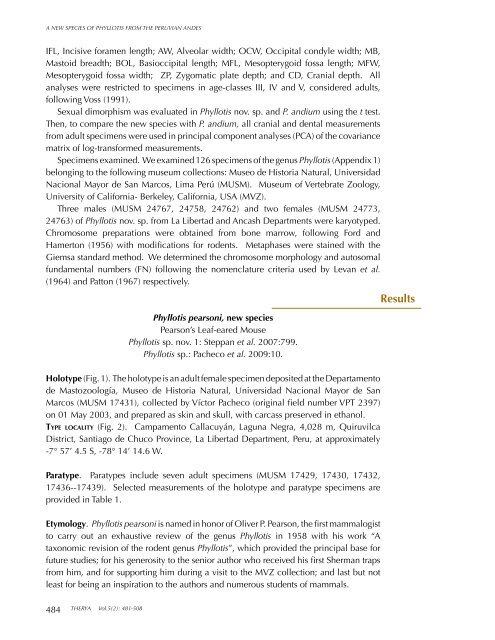therya-5_2
therya-5_2
therya-5_2
Create successful ePaper yourself
Turn your PDF publications into a flip-book with our unique Google optimized e-Paper software.
A NEW SPECIES OF PHYLLOTIS FROM THE PERUVIAN ANDES<br />
IFL, Incisive foramen length; AW, Alveolar width; OCW, Occipital condyle width; MB,<br />
Mastoid breadth; BOL, Basioccipital length; MFL, Mesopterygoid fossa length; MFW,<br />
Mesopterygoid fossa width; ZP, Zygomatic plate depth; and CD, Cranial depth. All<br />
analyses were restricted to specimens in age-classes III, IV and V, considered adults,<br />
following Voss (1991).<br />
Sexual dimorphism was evaluated in Phyllotis nov. sp. and P. andium using the t test.<br />
Then, to compare the new species with P. andium, all cranial and dental measurements<br />
from adult specimens were used in principal component analyses (PCA) of the covariance<br />
matrix of log-transformed measurements.<br />
Specimens examined. We examined 126 specimens of the genus Phyllotis (Appendix 1)<br />
belonging to the following museum collections: Museo de Historia Natural, Universidad<br />
Nacional Mayor de San Marcos, Lima Perú (MUSM). Museum of Vertebrate Zoology,<br />
University of California- Berkeley, California, USA (MVZ).<br />
Three males (MUSM 24767, 24758, 24762) and two females (MUSM 24773,<br />
24763) of Phyllotis nov. sp. from La Libertad and Ancash Departments were karyotyped.<br />
Chromosome preparations were obtained from bone marrow, following Ford and<br />
Hamerton (1956) with modifications for rodents. Metaphases were stained with the<br />
Giemsa standard method. We determined the chromosome morphology and autosomal<br />
fundamental numbers (FN) following the nomenclature criteria used by Levan et al.<br />
(1964) and Patton (1967) respectively.<br />
Phyllotis pearsoni, new species<br />
Pearson’s Leaf-eared Mouse<br />
Phyllotis sp. nov. 1: Steppan et al. 2007:799.<br />
Phyllotis sp.: Pacheco et al. 2009:10.<br />
Holotype (Fig. 1). The holotype is an adult female specimen deposited at the Departamento<br />
de Mastozoología, Museo de Historia Natural, Universidad Nacional Mayor de San<br />
Marcos (MUSM 17431), collected by Víctor Pacheco (original field number VPT 2397)<br />
on 01 May 2003, and prepared as skin and skull, with carcass preserved in ethanol.<br />
Type locality (Fig. 2). Campamento Callacuyán, Laguna Negra, 4,028 m, Quiruvilca<br />
District, Santiago de Chuco Province, La Libertad Department, Peru, at approximately<br />
-7° 57’ 4.5 S, -78° 14’ 14.6 W.<br />
Paratype. Paratypes include seven adult specimens (MUSM 17429, 17430, 17432,<br />
17436--17439). Selected measurements of the holotype and paratype specimens are<br />
provided in Table 1.<br />
Etymology. Phyllotis pearsoni is named in honor of Oliver P. Pearson, the first mammalogist<br />
to carry out an exhaustive review of the genus Phyllotis in 1958 with his work “A<br />
taxonomic revision of the rodent genus Phyllotis”, which provided the principal base for<br />
future studies; for his generosity to the senior author who received his first Sherman traps<br />
from him, and for supporting him during a visit to the MVZ collection; and last but not<br />
least for being an inspiration to the authors and numerous students of mammals.<br />
Results<br />
484<br />
THERYA Vol.5(2): 481-508



